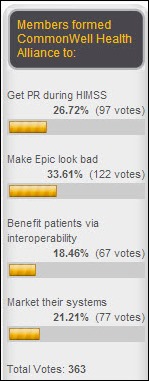Merry Christmas and a Happy New Year to the HIStalk crowd. I wish you the joys of the season!
Monday Morning Update 3/18/13
From E2M: “Re: enterprise to mobile. To make CPOE, portal, or other EHR component mobile, you either build it from scratch or build a new set of apps on top of the existing infrastructure. Capriza allows anyone without any programming skill to transfer an existing Web-based enterprise app to mobile in minutes.” Maybe someone will give it a try and report back. It seems pretty cool – you create what looks like a screen scrape type mobile front end to an existing web app by just dragging and adjusting.
From Spinnaker: “Re: Epic. I heard a rumor at HIMSS that they’ve signed some international deals, two more hospitals in the UK and one in Australia. Heard anything?” I haven’t heard anything recently, but someone can probably confirm. Usually someone attending an Epic class in Verona can verify that the new customers had people there.
From Pointy Ears: “Re: another athenahealth executive headed to CareCloud? Tom Cady, VP of professional services, has left.” Unverified, but reported by a couple of readers.
It’s time for my annual reader survey. I use it to plan the next year of HIStalk, so it would help me a lot if you could answer 10 questions.
Thanks to the following sponsors, new and renewing, that recently supported HIStalk, HIStalk Practice, and HIStalk Connect. Click a logo for more information.
Fewer than one in five poll respondents think CommonWell was formed with the primary purpose of benefiting patients. New poll to your right: how has your perception of Allscripts changed since Paul Black took over?
Welcome to new HIStalk Platinum sponsor Quantros. The company offers SaaS-based healthcare quality and safety performance improvement systems with over 2,000 healthcare facilities as customers (Kaiser, NYU Langone, Ochsner, Scott & White, Exempla, etc.)Products include SRM safety and risk management (safety events, feedback, disruptive events, claims, MEDMARX ADE date repository, PSO submission); IRIS Executive (enterprise-wide patient safety system); ACE (continuous compliance readiness); and RRM regulatory reporting (Meaningful Use reporting, core measures, CM reporting). Quantros helps providers improve quality and safety by empowering all levels with actionable intelligence to improve outcomes and reduce risk. Thanks to Quantros for supporting HIStalk.
Here’s a new Quantros video featuring CEO Keith Hagen honoring National Patient Safety Week, which ironically was overshadowed by the overlapping HIMSS conference.
Suzanne Bledsoe and Wes Scruggs purchase oncology IT consulting firm Aptium Oncology from AstraZeneca PLC.
Here’s a nice shot of Dr. Gregg playing Quipstar at the Medicomp booth at the HIMSS conference.
Dodge Communications posts its much-awaited snarky review of the HIMSS exhibit hall and surrounding areas (like why so many of you were buying sushi from that sketchy kiosk out in the hall).

I like the Meaningful Use attestation reports created by Wells Fargo Securities. Jamie Stockton, who is in Wells Fargo’s HIT equity research group and creates the report, e-mailed to say he’ll add any interested provider or vendor to his distribution list if you send him an e-mail.
Speaking of attestation data, Social Health Insights, which did the MappyHealth Twitter health term trend monitoring system, did a visualization of Medicare hospitals that have attested to Meaningful Use that also includes their HCAHPS scores. Make sure to scroll down since a lot of information about individual hospitals has been mashed up.
A House committee will ask the FDA in hearings this week about any plans it has to regulate or tax mobile health apps.
Microsoft lists software products supporting Windows 8 that were shown at the HIMSS conference.
Epocrates shareholder Goldman Sachs sells its remaining stake in the company for $32.5 million following its acquisition by athenahealth. Goldman bought $40 million worth of shares in 2007 and sold them for a total of $36.5 million after its plan to create an institutional investor research firm failed.
Weird News Andy has a solution for this problem: move to Australia. A Serbian woman sees images upside down due to a rare brain condition.
Vince’s HIS-tory this week begins the tale of Meditech. He would appreciate your nuggets and ephemera if you lived the company’s history.
Contacts
Mr. H, Inga, Dr. Jayne, Dr. Gregg, Lt. Dan, Dr. Travis.
More news: HIStalk Practice, HIStalk Connect.











































Maybe it’s just me, but I think you may be underestimating the importance of Commonwell. For one thing, it’s a lot of trouble to go through if they’re only trying to make Epic look bad, and if any bad was had, it was almost surely self-inflicted. I’ve worked in the HIMSS Interoperability Showcase for the last couple of years and there is some real synergy building there, very commonly between rival vendors. I believe they all understand that the value of health information is proportional to it’s ubiquity and inversely so to the effort one goes through to get to it and are really trying to make interoperability a reality, if only to sell more systems (by providing value to customers and their clients, the patients.)
I may be wrong, I’ve certainly been wrong before, but I think that while a certain degree of cynicism may be generally applicable to HIT, it’s misapplied in this case. The market is driving this effort and some positive results have already been realized, especially as we/they progress in this effort, the standards and infrastructure developed should be benefit to us all (even those vendors who do not participate.)
Nice pic of Dr. Gregg at HIMSS. Who knew he cleaned up so well????!!!!! Kinda cute.
Capriza would only work if you already had a web app to base it off of. It essentially (based on what the little info on their site suggests) lets you select UI elements off an existing web page and builds a new mobile web app from it, probably proxying the real site behind-the-scenes and only showing you your new one. It would be nice if you used limited features of a third party website that didn’t offer a mobile version, but you wanted your workforce to have a mobile version, or you wanted to reskin a site to look more like it’s part of your enterprise.
Of course, most enterprise EHRs don’t offer web versions anyway, so this wouldn’t be useful. I’m guessing it also won’t work very well for AJAX-enabled sites that rely heavily on front-end Javascript to function. Might be a good way to make your patient portal “mobile”, though, and brand it at the same time.
Lincoln, if those vendors seriously cared about patients and doctors there was a preset option to put their weight behind. NwHIN is where this will land.
About Congress hearings: “The hearings come in the wake of a March 1 letter to FDA Commissioner Margaret A. Hamburg by leaders of the committee, asking when guidance on the rules would come, whether FDA has considered the tax consequences for device makers, and specifics on mobile medical apps that have already sought FDA approval.”
The FDA is already regulating MMAs and has given approval for several, even though they are meaningfully clinically useless in the provision of medical care and will not improve outcomes. They all should be studied by protocol and have after market surveillance to assure safety.
Sounds like the industry has convinced Congress to fight in its corner.
@ Lincoln F: As you correctly observe, the testing and demonstrations that are part of the IHE process, culminating in the HIMSS Interoperability Showcase, show “some real synergy building there, very commonly between rival vendors”. It takes time and commitment for the standards to be tested and settle down, so that they can be made part of existing applications. Ironically, Greenway published a white paper (http://www.iheusa.org/docs/IHEWhitePaperProfilesandCCDExchange_001.pdf) on how patient identification and targeted queries work in the real world using IHE specifications, the same ones that are underlying the NHIN/NwHIN/Health-e-way standards.
This is why for many the Commonwell announcement doesn’t make much sense. The guest article in Forbes painted a dire picture that needs solution, but it is mostly a straw-man argument. It sounded like the two large organizations that are driving the effort are hell-bent on re-inventing the wheel, while neglecting the reality that any new standards will have to go through a process of “fermentation” and validation, which puts any meaningful results in the 5-10 year horizon. A cynic may think that this could be their goal – to slow down the adoption of interoperability standards, in order for the laggards to catch up.
It remains to be seen how sincere are the pledges for making the alliance members’ products work with the existing interoperability efforts. Several IHE technical committees are meeting this week and during the first week of May – will there be representatives of the alliance at these meeting? There are two areas where the Commonwell may have a point about the need for infrastructure – the need for a global (centralized or federated) directory of providers and their interoperability capabilities; and the management of consent and data release authorization. If the new organization steps up with the infrastructure effort built on the existing standards, that would be the best indication that it is indeed a worthy effort, and not the usual marketing fluff that usually surrounds HIMSS…
Re: The HIMSS sushi … it wasn’t THAT bad. After waiting in line for.ev.er on Day 1 for something resembling healthy, I had sushi the next 2 days for lunch – I did stick to the vegetarian option, tho.
Actually, the jambalaya from the kiosk around hall G-H wasn’t that bad either – with enough hot sauce poured on…
@Anonymous – You’re right, Capriza is built for mobilizing existing web applications (really any SaaS solution). As you noted, this means that users of those old client systems will still be out of luck when it comes to mobility. After testing Capriza out on a few sites, I see that it actually can handle a limited amount of AJAX on a page, but an AJAX-heavy site like Gmail poses a challenge to the technology.
Side note: I’m confident that the growing number of SaaS solutions for healthcare will eventual penetrate hospitals and private practices and, as a result, make Capriza (among other services) very relevant.